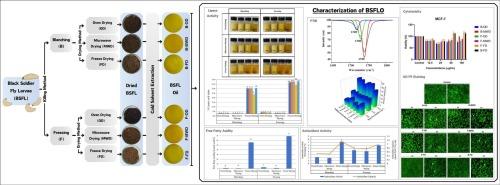杀干方法对黑兵蝇油理化及功能特性的影响
IF 9.8
1区 农林科学
Q1 CHEMISTRY, APPLIED
引用次数: 0
摘要
黑虻幼虫(BSFL)是一种很有前途的富含脂肪的功能性食品原料。本研究旨在评价不同的杀菌(焯水或冷冻)和干燥(烘箱、微波或冷冻干燥)方法对冷溶剂提取BSFL油的理化和生物学特性的影响。采用不同的灭杀(焯水、冷冻)和干燥(烘箱、微波、冷冻干燥)方法,然后进行冷溶剂提取。月桂酸为主。冻干样品的游离脂肪酸含量最高(55.8-69.1 %),微波和烤箱干燥样品的游离脂肪酸含量较低(0.6-2.6 %)。FTIR显示冻干油水解,酯峰减少(1740 cm−1),酸峰增加(1720 cm−1)。所有TBARS值均低于0.03 mg MDA/kg,表明氧化程度较低。冻干油的抗氧化活性最高。BSFLO (B-OD、B-MWD和F-OD)部分抑制MCF-7细胞增殖,浓度为25 μg/mL。加工在塑造BSFLO的质量中起着关键作用,这表明了它的潜在用途。本文章由计算机程序翻译,如有差异,请以英文原文为准。


Impact of killing and drying methods on physicochemical and functional properties of black soldier fly larvae (BSFL) oil
Black soldier fly larvae (BSFL) are a promising fat-rich alternative as a functional food ingredient. This study aimed to evaluate how different killing (blanching or freezing) and drying (oven, microwave, or freeze-drying) methods influence physicochemical and biological properties of cold solvent-extracted BSFL oil. Larvae were subjected to different killing (blanching, freezing) and drying (oven, microwave, freeze-drying) methods, followed by cold solvent extraction. Lauric acid was predominant. Freeze-dried samples exhibited highest free fatty acid content (55.8–69.1 %), while microwave and oven-dried samples showed lower values (0.6–2.6 %). FT-IR indicated hydrolysis in freeze-dried oils, with reduced ester (1740 cm−1) and increased acid (1720 cm−1) peaks. All TBARS values remained below 0.03 mg MDA/kg, indicating low oxidation. Antioxidant activity was highest in freeze-dried oils. BSFLO (B-OD, B-MWD and F-OD) partially inhibited proliferation of MCF-7 cells, at 25 μg/mL. Processing plays a key role in shaping BSFLO's quality, indicative of its potential use.
求助全文
通过发布文献求助,成功后即可免费获取论文全文。
去求助
来源期刊

Food Chemistry
工程技术-食品科技
CiteScore
16.30
自引率
10.20%
发文量
3130
审稿时长
122 days
期刊介绍:
Food Chemistry publishes original research papers dealing with the advancement of the chemistry and biochemistry of foods or the analytical methods/ approach used. All papers should focus on the novelty of the research carried out.
 求助内容:
求助内容: 应助结果提醒方式:
应助结果提醒方式:


